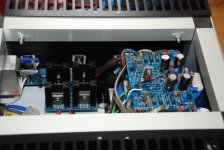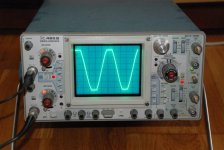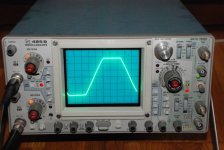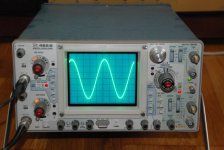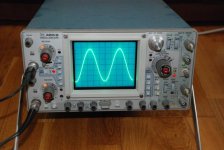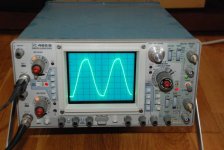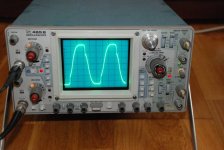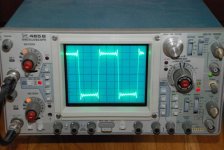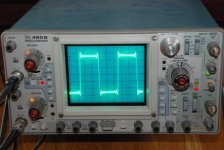What type of tube amplifier are you comparing it to?
My tube amplifier is a 4 KT88 PP per channel in triode mode
Does the absolute DC offset stay fairly steady at 350mV? or does it drift slightly?
When I connect the amplifier I have around 4v of absolute DC offset that goes down quickly to less than 1v and then needs one hour to go downto around 350mV. It stays between 340 and 360mV.
However, these numbers are only for the second channel. The first channel I did was not as good. The DC offset between outputs is about 60mV and the absolute DC offset about 900mV. I plan to change the input differential fets for this channel. In fact, for the second channel, I used a socket so I could try some of them in real conditions. I will definately do the same for the first channel.
can you notice any hum at your speakers? I am going through final tweaks on my pair and have a faint hum at the speaker still, however I still plan to eliminate it completely (and post some pictures) when I get some free time. It is definatley a slow process
I only notice some hum at the speakers if I am closer than 2 meters. The ripple I measured was about 80mV.
I am also in the process of fine tunning the amps, but I want to stay some weeks just listening music and enjoying the amp. Then I'll start the tweaks.
I agree with you it is a slow process, but it pays when you just have finish the amp and you enjoy it with your favourite music drinking your favourite red wine!
Xavier
Stefanoo said:Hi!
i noticed that you used mills resistors...isn't it?
Another thing.....on your picture i can see just a part of your loudspeakers...are your speakers B&W?! they really look like!
I don't know if oyu gave the necessary time to the amp to burn in all the new components.....how does it sound like so far?
What stereo parts do you have?...cables...source....speakers....?
Best,
Stefano.
Still waiting to know the things quoted above
Hi Stefanoo,
I forgot to answer your questions in the first page. Sorry about that!
Amplifier Aleph X
Preamp Aleph P1.7
CD Rotel rcd991 modded
Phono preamp Aleph Pearl (with MC pre and differential output)
Turntable Michel Syncro + cartridge Shelter 901
Ciao,
Xavier
I forgot to answer your questions in the first page. Sorry about that!
Yes. The source resistors and output resistors are Mills. The rest are Dale CMF-55-143.i noticed that you used mills resistors...isn't it?
You are right. They are B&W Nautilus 803. Although they are marked as 8 Ohms, their minimum impedance is 3 Ohms. That is the reason for having quite high bias (7.2A per channel).Another thing.....on your picture i can see just a part of your loudspeakers...are your speakers B&W?! they really look like!
Not yet, but I don't expect too many changes in the quality of the sound. In fact one of the channels was up two weeks before the other and they sound the same.I don't know if oyu gave the necessary time to the amp to burn in all the new components.....how does it sound like so far?
Speakers: B&W 803What stereo parts do you have?...
Amplifier Aleph X
Preamp Aleph P1.7
CD Rotel rcd991 modded
Phono preamp Aleph Pearl (with MC pre and differential output)
Turntable Michel Syncro + cartridge Shelter 901
Ciao,
Xavier
After some days of listening, I did some fine tunning to the amps:
1- I reduced the relative DC offset of both channels by changing the differential pairs (I have sockets on both channels). Now I have 7 mV in one channel and 25mV in the other.
2- I noticed that when puting the cover to the enclosure, there is an increase of the temperature that produces changes. The absolute offset increased about 1v so I had to re-adjust V2 through the holes of the cover, without removing it.
The cover was also reducing the bias. I had to re-adjust V1 and V3. Doing so through the cover was quite easy. Measuring the voltage at the source resistors was more difficult. I had to remove the cover and measure each resistor immediately since once the cover was removed, the voltage drifted very quickly. Any alternative ideas on how to measure the bias of each side of the channel without removing the cover would be appreciated!
3- In order to reduce the remaining hum, I added two capacitors in parallel (1000 + 10000 uF) right at the mosfets for each side, i.e. a total of 22000 per channel (see the picture). Each pair is connected to the drain of the current source (V+) and the source resistor of the output devices (V-) for each side of the monoblock.
This totally removed the remaining hum in the left channel while for the right channel, you have to put your ear almost against the speaker to hear some noise.
Xavier
1- I reduced the relative DC offset of both channels by changing the differential pairs (I have sockets on both channels). Now I have 7 mV in one channel and 25mV in the other.
2- I noticed that when puting the cover to the enclosure, there is an increase of the temperature that produces changes. The absolute offset increased about 1v so I had to re-adjust V2 through the holes of the cover, without removing it.
The cover was also reducing the bias. I had to re-adjust V1 and V3. Doing so through the cover was quite easy. Measuring the voltage at the source resistors was more difficult. I had to remove the cover and measure each resistor immediately since once the cover was removed, the voltage drifted very quickly. Any alternative ideas on how to measure the bias of each side of the channel without removing the cover would be appreciated!
3- In order to reduce the remaining hum, I added two capacitors in parallel (1000 + 10000 uF) right at the mosfets for each side, i.e. a total of 22000 per channel (see the picture). Each pair is connected to the drain of the current source (V+) and the source resistor of the output devices (V-) for each side of the monoblock.
This totally removed the remaining hum in the left channel while for the right channel, you have to put your ear almost against the speaker to hear some noise.
Xavier
Attachments
I did some measurements for 8R and 4R loads.
The measured peak voltage before clipping was 32v (22,6v RMS) for 8R and 28v (19,8v RMS) for 4R. I measured +17,54 and -17,58 from psu and bias about 7.2A
The voltage before clipping for 4R is a little bit less than expected for 4R (98W instead of the 105W according to the excel sheet). I tried to increase the bias to see where was the limitation but I was having 28v consistently, so probably the voltage loss at the fets and the source resistor is higher than expected.
Clipping at 1KHz and Z=8R
The measured peak voltage before clipping was 32v (22,6v RMS) for 8R and 28v (19,8v RMS) for 4R. I measured +17,54 and -17,58 from psu and bias about 7.2A
The voltage before clipping for 4R is a little bit less than expected for 4R (98W instead of the 105W according to the excel sheet). I tried to increase the bias to see where was the limitation but I was having 28v consistently, so probably the voltage loss at the fets and the source resistor is higher than expected.
Clipping at 1KHz and Z=8R
Attachments
Dear Xavier,
thanks for your data.
Can you check if the sine wave at 10kHz (or hihger is better) is correct just before the clipping?(On my Aleph-x (I hope to post it in the next fews weeks), I notice same strange shape (not clipping) at high frequency before the clipping (3-4V).).
My power supply is -21 + 21, and I notice this "strange" shape at 22Vrms output (on 8R).
Thanks Paolo
thanks for your data.
Can you check if the sine wave at 10kHz (or hihger is better) is correct just before the clipping?(On my Aleph-x (I hope to post it in the next fews weeks), I notice same strange shape (not clipping) at high frequency before the clipping (3-4V).).
My power supply is -21 + 21, and I notice this "strange" shape at 22Vrms output (on 8R).
Thanks Paolo
Phase shift @20KHz???
I couldn't find too much information about phase shift or distortion at high frequencies. I found this post from Neson Pass refered to Aleph 3
So I tried to decrease the AC Gain from 54% to 49.6% while I increased the bias from 7.2 to 7.4A to maximize the power at 4R.
The resulting waveform at 20KHz (just before clipping) was very similar to the one I showed before.
So, no improvement in that, but the sound was better now. I don't know how to describe it. The sound is even more clear now. The piano Sounds more like a piano.
Anyway, I would like to understand what is happening between 10KHz and 20KHz at high output voltages. Anyone could help?
I couldn't find too much information about phase shift or distortion at high frequencies. I found this post from Neson Pass refered to Aleph 3
Nelson Pass said:When you deviate from the 50% figure for current gain
on the current source, you get more distortion at the
highest output, either because you are current-starved,
or because the current source is shutting off on negative
peaks. The cure in both cases is more bias.
Come to think of it, more bias is almost always the cure
for any limitations of Alephs.
So I tried to decrease the AC Gain from 54% to 49.6% while I increased the bias from 7.2 to 7.4A to maximize the power at 4R.
The resulting waveform at 20KHz (just before clipping) was very similar to the one I showed before.
So, no improvement in that, but the sound was better now. I don't know how to describe it. The sound is even more clear now. The piano Sounds more like a piano.
Anyway, I would like to understand what is happening between 10KHz and 20KHz at high output voltages. Anyone could help?
Try comparing the output to the output (drains) of the input devices. If you see the distortion there, then it is probably in the input stage (although, I am unsure as to what effect the feedback would play).
I have seen a lot of different distortion signatures with the BZLS, where the tops of the output sinewaves start to flatten off or do other strange things, like curling to the right or left ever so slightly.
JJ
I have seen a lot of different distortion signatures with the BZLS, where the tops of the output sinewaves start to flatten off or do other strange things, like curling to the right or left ever so slightly.
JJ
Hi JJ,
I checked the output between the drains of the input devices for different frequencies and levels:
100Hz: the wave was perfect at low levels and high levels
1KHz: the wave was perfect at low levels and less perfect at high levels
20KHz: the wave was perfect at low levels and really distorted at high levels, much more than the wave at the output when using the same input level.
Now I am a little bit lost.
Could it be that when measuring there I am introducing more distortion or interfering the signal in any way?
Xavier
I checked the output between the drains of the input devices for different frequencies and levels:
100Hz: the wave was perfect at low levels and high levels
1KHz: the wave was perfect at low levels and less perfect at high levels
20KHz: the wave was perfect at low levels and really distorted at high levels, much more than the wave at the output when using the same input level.
Now I am a little bit lost.

Could it be that when measuring there I am introducing more distortion or interfering the signal in any way?
Xavier
20KHz: the wave was perfect at low levels and really distorted at high levels, much more than the wave at the output when using the same input level
Well I think that definitely tells us something -- but I don't enough about the circuit to interpret what is happening there. I wish I did.......
My scope is dual trace -- I never saw any effect on the outputs of my aleph mini when I connected probes to the drains of the input devices.
JJ
- Status
- This old topic is closed. If you want to reopen this topic, contact a moderator using the "Report Post" button.
- Home
- Amplifiers
- Pass Labs
- Another Aleph X up and running
